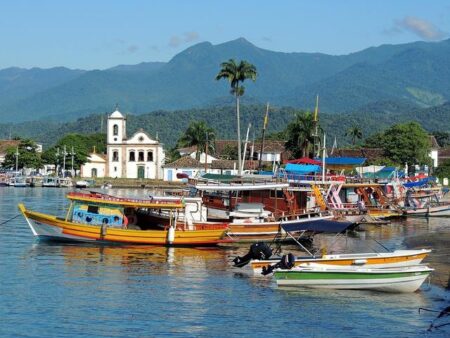On the lush Combu Island, nestled within the Amazon River near Brazil’s bustling city of BelĂ©m, a unique group of chocolate makers is drawing international attention-not just for the rich flavors of their craft, but for their role in climate action. As the planet grapples with escalating environmental challenges, these artisans are demonstrating how sustainable practices in traditional agriculture can offer valuable lessons in resilience and conservation. Their approach, highlighted recently by the United Nations, underscores the vital connection between protecting local ecosystems and combating global climate change.
Sustainable Cocoa Farming Practices on Combu Island Offer Model for Climate Resilience
On Combu Island, nestled within the Amazon River delta, small-scale cocoa farmers have pioneered a set of farming methods that not only enhance crop yields but also bolster the ecosystem’s resilience to climate change. These growers employ a combination of agroforestry and organic cultivation techniques, integrating native tree species with cocoa plants to create a diverse, shaded environment that reduces soil erosion and moderates temperature extremes. By doing so, they help maintain soil fertility and increase biodiversity, ensuring the land remains productive even as weather patterns shift unpredictably.
Key sustainable practices embraced by these farmers include:
- Intercropping: Planting multiple species alongside cocoa to mimic natural forest conditions.
- Water conservation: Utilizing rainwater harvesting and mulching to retain moisture during dry spells.
- Natural pest management: Reducing chemical inputs by encouraging beneficial insects.
These strategies exemplify climate adaptation at a grassroots level, offering valuable lessons for cocoa producers worldwide. As global demand for sustainable chocolate grows, the Combu model highlights how traditional knowledge and modern innovation can combine to protect both livelihoods and the planet.
| Practice | Benefit | Climate Impact |
|---|---|---|
| Agroforestry | Soil enrichment & biodiversity | Carbon sequestration |
| Rainwater Harvesting | Improved water access | Drought resilience |
| Natural Pest Control | Reduced chemical use | Healthier ecosystems |
Local Chocolate Makers Showcase Community-Driven Solutions to Deforestation and Emissions
On the lush landscapes of Combu Island, just off the coast of Brazil’s Amazon, local chocolate makers are pioneering environmentally conscious practices that offer practical solutions to combat deforestation and reduce carbon emissions. By integrating agroforestry techniques with sustainable cocoa cultivation, these artisans not only protect vital forest ecosystems but also promote biodiversity. Their work illustrates how community-driven agriculture can serve as a frontline defense against climate change, empowering local populations while preserving natural heritage.
Key strategies embraced by these chocolate producers include:
- Shade-grown cocoa farming that maintains tree cover and supports wildlife habitats
- Use of organic fertilizers and natural pest control, reducing chemical runoff and soil degradation
- Community-based monitoring initiatives to track forest health and prevent illegal logging
| Impact Area | Community Approach | Outcome |
|---|---|---|
| Deforestation | Agroforestry with native species | Reduced tree loss by 40% |
| Emissions | Organic soil management | Cut carbon footprint by 30% |
| Local Economy | Fair trade practices | Increased income by 25% |
Empowering Indigenous Producers Critical to Scaling Climate Action in the Amazon
On Combu Island, nestled in the heart of Brazil’s Amazon, Indigenous chocolate producers are demonstrating how traditional knowledge and sustainable practices can form the backbone of effective climate strategies. These artisans cultivate cacao in harmony with the forest, maintaining biodiversity and preventing deforestation. Their approach underscores the pivotal role Indigenous communities play in preserving vital carbon sinks and fostering climate resilience. By protecting their ancestral lands and incorporating environmentally friendly farming methods, they not only produce premium chocolate but also contribute to global efforts against climate change.
Key practices contributing to climate action include:
- Agroforestry systems: Integrating cacao plants with native trees to enhance carbon capture and soil health.
- Community governance: Collective land management prevents illegal logging and mining activities.
- Traditional knowledge: Techniques passed down for generations support ecosystem balance and biodiversity.
| Practice | Climate Benefit | Community Impact |
|---|---|---|
| Mixed-species agroforestry | Increased carbon sequestration | Stronger ecosystem resilience |
| Controlled harvesting methods | Sustainable resource use | Stable livelihoods |
| Land stewardship traditions | In Conclusion
As Brazil’s Combu Island demonstrates, the intersection of traditional knowledge and sustainable practices offers a promising path forward in the global fight against climate change. The efforts of local chocolate makers not only preserve a unique cultural heritage but also provide valuable insights into resilient agricultural methods. Their experience underscores the importance of community-driven solutions in achieving broader environmental goals, serving as a compelling example for policymakers and stakeholders worldwide striving for effective and inclusive climate action. |




